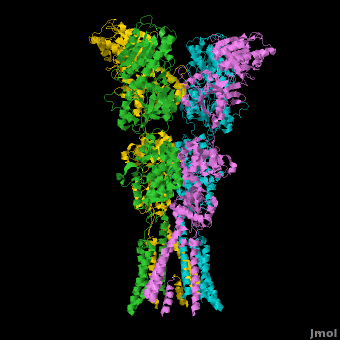Ionotropic Glutamate Receptors
From Proteopedia
(Difference between revisions)
| Line 8: | Line 8: | ||
<scene name='Ionotropic_Glutamate_Receptors/Atd_opening/2'>The ATD</scene> is responsible for receptor assembly, trafficking and localization. It has two unique sets of interactions which hold the tetramer together. The <scene name='Ionotropic_Glutamate_Receptors/Atd_dimer_interactions/1'>first set of interactions</scene> is present in each pair of dimers and involves both hydrogen bonding and hydrophobic interactions. The <scene name='Ionotropic_Glutamate_Receptors/Atd_two_dimers_interaction/3'>second set</scene>, which includes residues Ile 203, Thr 204, Ile 205, and Val 209 on both chains among others, effectively holds the pair of dimers together at an angle that is roughly 24 degrees off of the overall two-fold axis.<ref name="Sobo"/><ref>PMID: 19461580</ref> | <scene name='Ionotropic_Glutamate_Receptors/Atd_opening/2'>The ATD</scene> is responsible for receptor assembly, trafficking and localization. It has two unique sets of interactions which hold the tetramer together. The <scene name='Ionotropic_Glutamate_Receptors/Atd_dimer_interactions/1'>first set of interactions</scene> is present in each pair of dimers and involves both hydrogen bonding and hydrophobic interactions. The <scene name='Ionotropic_Glutamate_Receptors/Atd_two_dimers_interaction/3'>second set</scene>, which includes residues Ile 203, Thr 204, Ile 205, and Val 209 on both chains among others, effectively holds the pair of dimers together at an angle that is roughly 24 degrees off of the overall two-fold axis.<ref name="Sobo"/><ref>PMID: 19461580</ref> | ||
=====The Transmembrane Domain===== | =====The Transmembrane Domain===== | ||
| - | | + | <scene name='Ionotropic_Glutamate_Receptors/Tmd_opening/2'>The TMD</scene> has a pore structure that is nearly identical to that of the [[Potassium Channel]]. With complete four-fold symmetry, 16 helices form a **precise pore** through which cations can flow through. In the current, inhibitor bound structure, the M3 helices cross at a highly conserved **SYTANLAAF motif**, with Thr 617, Ala 621, and Thr 625 **occluding the ion permeation pathway**.<ref name="Sobo"/> The **narrowest part** of the channel includes the residues Met 629, Thr 625, Ala 621, and Thr 617. Located next to this narrow region lies **Alanine 622**, which is replaced with a threonine in the Lurcher mouse model mentioned previously. This mutation, which introduces a significantly bulkier residue, destabilizes the tight helix crossing associated with the closed state of the receptor, resulting in a constitutively open ion channel.<ref name="Sobo"/> |
=====The Ligand Binding Domain===== | =====The Ligand Binding Domain===== | ||
**The LBD** is located just above the TMD. It has an overall two-fold axis of symmetry with two major groups of interactions which hold the homotetramer together. The **first set of interactions** which holds each dimer together includes residues >>>>>>>>>>>>>>. The **second set of interactions** includes residues >>>>>>>>>>>>>, holding the two dimers in their tetrameric position. Within each LBD lies the so-called **“clamshell”**. This structure is responsible for binding glutamate and “sensitizing” the receptor to allow passage of cations through the channel. Residues >>>>>>>>>>>>, which are responsible for **tightly binding glutamate** within the clamshell, are highly conserved. Glutamate binding causes a conformational change in the LBD which pulls the M3 helices in the TMD apart, opening the channel and allowing for cation passage. A morph of the conformational change in the LBD upon glutamate binding can be **seen here**. Uniquely, due to the varied importance of the homotetramer subunits due to symmetry mismatch, the interaction of glutamate with the **distal subunits** is predicted to result in a greater conformational change and thus plays a more critical role in channel sensitization and activation.<ref name="Sobo"/> | **The LBD** is located just above the TMD. It has an overall two-fold axis of symmetry with two major groups of interactions which hold the homotetramer together. The **first set of interactions** which holds each dimer together includes residues >>>>>>>>>>>>>>. The **second set of interactions** includes residues >>>>>>>>>>>>>, holding the two dimers in their tetrameric position. Within each LBD lies the so-called **“clamshell”**. This structure is responsible for binding glutamate and “sensitizing” the receptor to allow passage of cations through the channel. Residues >>>>>>>>>>>>, which are responsible for **tightly binding glutamate** within the clamshell, are highly conserved. Glutamate binding causes a conformational change in the LBD which pulls the M3 helices in the TMD apart, opening the channel and allowing for cation passage. A morph of the conformational change in the LBD upon glutamate binding can be **seen here**. Uniquely, due to the varied importance of the homotetramer subunits due to symmetry mismatch, the interaction of glutamate with the **distal subunits** is predicted to result in a greater conformational change and thus plays a more critical role in channel sensitization and activation.<ref name="Sobo"/> | ||
Revision as of 00:01, 13 March 2011
| |||||||||||
Additional Resources
For additional information on the Symmetry of the Glutamate Receptor, See: Glutamate Receptor Symmetry Analysis
For Additional Information, See: Membrane Channels & Pumps
For Additional Information, See: Alzheimer's Disease
References
- ↑ 1.0 1.1 1.2 Jin R, Clark S, Weeks AM, Dudman JT, Gouaux E, Partin KM. Mechanism of positive allosteric modulators acting on AMPA receptors. J Neurosci. 2005 Sep 28;25(39):9027-36. PMID:16192394 doi:25/39/9027
- ↑ 2.0 2.1 2.2 2.3 2.4 2.5 2.6 Sobolevsky AI, Rosconi MP, Gouaux E. X-ray structure, symmetry and mechanism of an AMPA-subtype glutamate receptor. Nature. 2009 Dec 10;462(7274):745-56. Epub . PMID:19946266 doi:10.1038/nature08624
- ↑ 3.0 3.1 3.2 3.3 Purcell AE, Jeon OH, Zimmerman AW, Blue ME, Pevsner J. Postmortem brain abnormalities of the glutamate neurotransmitter system in autism. Neurology. 2001 Nov 13;57(9):1618-28. PMID:11706102
- ↑ Welsh JP, Ahn ES, Placantonakis DG. Is autism due to brain desynchronization? Int J Dev Neurosci. 2005 Apr-May;23(2-3):253-63. PMID:15749250 doi:10.1016/j.ijdevneu.2004.09.002
- ↑ Zuo J, De Jager PL, Takahashi KA, Jiang W, Linden DJ, Heintz N. Neurodegeneration in Lurcher mice caused by mutation in delta2 glutamate receptor gene. Nature. 1997 Aug 21;388(6644):769-73. PMID:9285588 doi:10.1038/42009
- ↑ Rubenstein JL, Merzenich MM. Model of autism: increased ratio of excitation/inhibition in key neural systems. Genes Brain Behav. 2003 Oct;2(5):255-67. PMID:14606691
- ↑ Jin R, Singh SK, Gu S, Furukawa H, Sobolevsky AI, Zhou J, Jin Y, Gouaux E. Crystal structure and association behaviour of the GluR2 amino-terminal domain. EMBO J. 2009 Jun 17;28(12):1812-23. Epub 2009 May 21. PMID:19461580 doi:10.1038/emboj.2009.140
Proteopedia Page Contributors and Editors (what is this?)
Michal Harel, David Canner, Wayne Decatur, Alexander Berchansky, Joel L. Sussman


